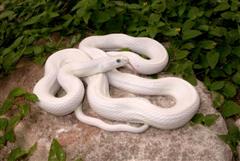Rat Snake - Texas
Texas Ratsnake Scientific Name: Elaphe obsoleta lindheimeri
Sun, 24th November, 2024 - 8:46 am GMT
Sponsor Ads:

Alternative Name
Texas Ratsnake Scientific Name: Elaphe obsoleta lindheimeriBasic Info
Although most Texas Rat Snakes reach lengths between four and five feet (one and half to one and nine tenths meters), specimens exceeding six feet are not unknown. Their bodies are of a slender type. Although most Texas Rat Snakes are blotched with saddle shapes, these darker patches usually fade as the reptiles age. Younger animals have better defined patterns. The background color of the Texas Rat Snake usually varies greatly from one locale to the next. Many are brown, though others have yellow shades, and some are mostly orange. The scales are keeled slightly. All Texas Rat Snakes have gray or black heads that have lighter white coloration underneath. Leucistic varieties are available, and many captive bred snakes are produced specifically for their unique colorations. It has been reported that bug eyed individuals are usually inbred and are less healthy than other individuals. And for this reason snakes with pure white bodies and black or blue eyes that do not protrude from the head should be used instead as pets or in breeding programs.
Health
Most Texas Rat Snakes will do well when kept at a daytime temperature of about 80 degrees Fahrenheit. Ideally, during the day, the snake should have access to a warm area between 85 and 90 degrees Fahrenheit and a cooler area between 75 and 80 degrees. At night the temperature should drop to about 70 degrees Fahrenheit. Temperatures can be lowered into the 60s at night on occasion, but 70 is ideal. Humidity should be moderate, and a bowl of water should be provided. Climbing opportunities should be provided for Texas Rat Snakes. Texas Rat Snakes should be fed once or twice each week on mice, rats, or chicks, depending on the size of your snake. Breeding Normally, Texas Rat Snakes lay their eggs between June and July. These are deposited in a protected area like a manure pile, a stump, a hollow tree, or a rock or sawdust heap. The average clutch contains between 5 and 20 eggs.Habitat
They are usually found in farmed or wooded areas, although they are also common in swampland and suburban areasBehavior
The Texas Rat Snake has been appreciated by many as a great form of rodent control in barns or attics. These snakes are beautiful, whether observed in the wild or kept in captivity, and are available in a great variety of colorings. Although usually found on the ground, they have been known to climb high into trees in order to access birds' nests. They have also been known to swim in rivers, hunting prey along the banks. Their defensive behavior is similar to that of a Rattle Snake; the Texas Rat Snake will vibrate is tail rapidly, though it lacks rattles. It will also coil its body and raise its head, and will rapidly strike over and over again at anything it perceives as a threat. It is not venomous. Texas Rat Snakes may not be the best choice for a beginner wishing to keep Rat Snakes. This species is often considered to have a more aggressive temperament than many Rat Snakes. It has been reported that this species lives between 15 and 25 years in captivity.Origin
Southern United StatesHistory
Texas Rat Snakes are found throughout most of Texas. . Although Texas Rat Snakes seem to frequent wetlands, they are not unknown in arid, rocky upland areas.Common Foods
In the wild, Texas Rat Snakes eat rodents. The most common prey items are rats and mice, and for this reason, this species is often found near the same human habitations that such rodents frequent. Texas Rat Snakes have also been known to eat eggs and birSponsor Ads:
The attention span of a computer is only as long as its electrical cord. -- Unknown
Rat Snake - Texas
Coded by: BGID® | ALL RIGHTS RESERVED Copyright © 2000-2024
Disclaimer | Privacy | Report Errors / Contact | Credits









 Beware the new Naval power, they are planning to come on stream with big naval might to match their ground forces. Chinese Aircraft Carrier - Chinese Navy
Beware the new Naval power, they are planning to come on stream with big naval might to match their ground forces. Chinese Aircraft Carrier - Chinese Navy  versus
versus 
 versus
versus  This Thread is about the North Korean Military itself - the kind of army, navy, and air force they have.
This Thread is about the North Korean Military itself - the kind of army, navy, and air force they have. 
 versus
versus  versus
versus 
 versus
versus  versus
versus